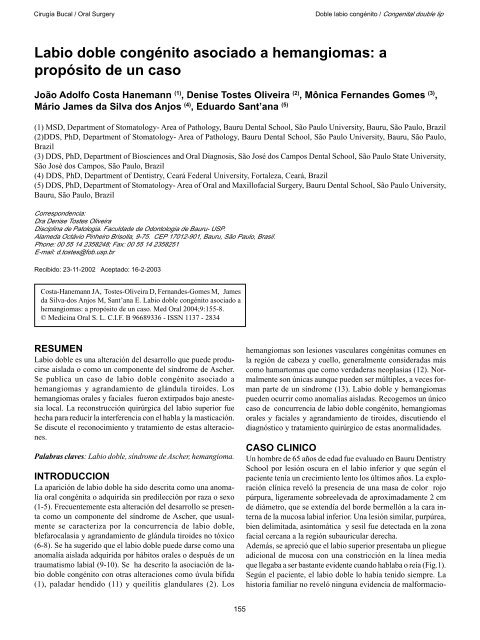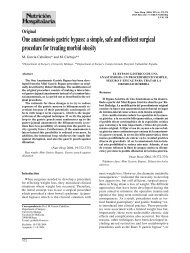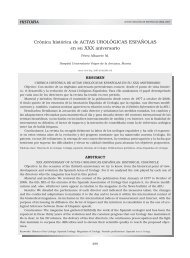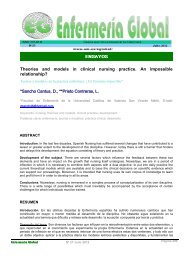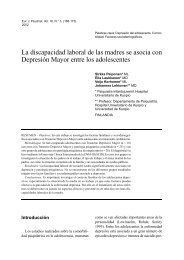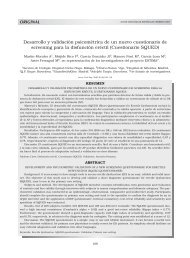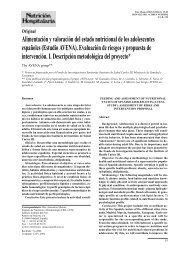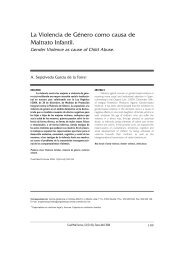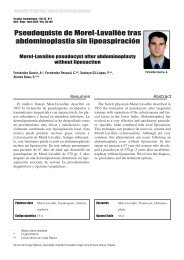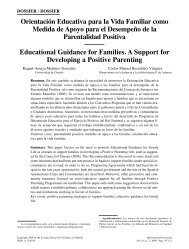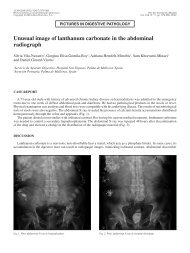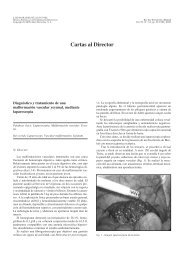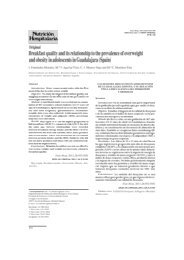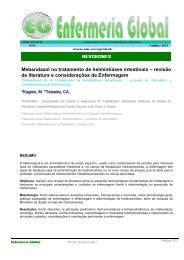Labio doble congénito asociado a hemangiomas: a propósito de un ...
Labio doble congénito asociado a hemangiomas: a propósito de un ...
Labio doble congénito asociado a hemangiomas: a propósito de un ...
You also want an ePaper? Increase the reach of your titles
YUMPU automatically turns print PDFs into web optimized ePapers that Google loves.
Cirugía Bucal / Oral Surgery Doble labio <strong>congénito</strong> / Congenital double lip<br />
<strong>Labio</strong> <strong>doble</strong> <strong>congénito</strong> <strong>asociado</strong> a <strong>hemangiomas</strong>: a<br />
<strong>propósito</strong> <strong>de</strong> <strong>un</strong> caso<br />
João Adolfo Costa Hanemann (1) , Denise Tostes Oliveira (2) , Mônica Fernan<strong>de</strong>s Gomes (3) ,<br />
Mário James da Silva dos Anjos (4) , Eduardo Sant’ana (5)<br />
(1) MSD, Department of Stomatology- Area of Pathology, Bauru Dental School, São Paulo University, Bauru, São Paulo, Brazil<br />
(2)DDS, PhD, Department of Stomatology- Area of Pathology, Bauru Dental School, São Paulo University, Bauru, São Paulo,<br />
Brazil<br />
(3) DDS, PhD, Department of Biosciences and Oral Diagnosis, São José dos Campos Dental School, São Paulo State University,<br />
São José dos Campos, São Paulo, Brazil<br />
(4) DDS, PhD, Department of Dentistry, Ceará Fe<strong>de</strong>ral University, Fortaleza, Ceará, Brazil<br />
(5) DDS, PhD, Department of Stomatology- Area of Oral and Maxillofacial Surgery, Bauru Dental School, São Paulo University,<br />
Bauru, São Paulo, Brazil<br />
Correspon<strong>de</strong>ncia:<br />
Dra Denise Tostes Oliveira<br />
Disciplina <strong>de</strong> Patologia. Faculda<strong>de</strong> <strong>de</strong> Odontologia <strong>de</strong> Bauru- USP.<br />
Alameda Octávio Pinheiro Brisolla, 9-75. CEP 17012-901, Bauru, São Paulo, Brasil.<br />
Phone: 00 55 14 2358248; Fax: 00 55 14 2358251<br />
E-mail: d.tostes@fob.usp.br<br />
Recibido: 23-11-2002 Aceptado: 16-2-2003<br />
Costa-Hanemann JA, Tostes-Oliveira D, Fernan<strong>de</strong>s-Gomes M, James<br />
da Silva-dos Anjos M, Sant’ana E. <strong>Labio</strong> <strong>doble</strong> <strong>congénito</strong> <strong>asociado</strong> a<br />
<strong>hemangiomas</strong>: a <strong>propósito</strong> <strong>de</strong> <strong>un</strong> caso. Med Oral 2004;9:155-8.<br />
© Medicina Oral S. L. C.I.F. B 96689336 - ISSN 1137 - 2834<br />
RESUMEN<br />
<strong>Labio</strong> <strong>doble</strong> es <strong>un</strong>a alteración <strong>de</strong>l <strong>de</strong>sarrollo que pue<strong>de</strong> producirse<br />
aislada o como <strong>un</strong> componente <strong>de</strong>l síndrome <strong>de</strong> Ascher.<br />
Se publica <strong>un</strong> caso <strong>de</strong> labio <strong>doble</strong> <strong>congénito</strong> <strong>asociado</strong> a<br />
<strong>hemangiomas</strong> y agrandamiento <strong>de</strong> glándula tiroi<strong>de</strong>s. Los<br />
<strong>hemangiomas</strong> orales y faciales fueron extirpados bajo anestesia<br />
local. La reconstrucción quirúrgica <strong>de</strong>l labio superior fue<br />
hecha para reducir la interferencia con el habla y la masticación.<br />
Se discute el reconocimiento y tratamiento <strong>de</strong> estas alteraciones.<br />
Palabras claves: <strong>Labio</strong> <strong>doble</strong>, síndrome <strong>de</strong> Ascher, hemangioma.<br />
INTRODUCCION<br />
La aparición <strong>de</strong> labio <strong>doble</strong> ha sido <strong>de</strong>scrita como <strong>un</strong>a anomalía<br />
oral congénita o adquirida sin predilección por raza o sexo<br />
(1-5). Frecuentemente esta alteración <strong>de</strong>l <strong>de</strong>sarrollo se presenta<br />
como <strong>un</strong> componente <strong>de</strong>l síndrome <strong>de</strong> Ascher, que usualmente<br />
se caracteriza por la concurrencia <strong>de</strong> labio <strong>doble</strong>,<br />
blefarocalasia y agrandamiento <strong>de</strong> glándula tiroi<strong>de</strong>s no tóxico<br />
(6-8). Se ha sugerido que el labio <strong>doble</strong> pue<strong>de</strong> darse como <strong>un</strong>a<br />
anomalía aislada adquirida por hábitos orales o <strong>de</strong>spués <strong>de</strong> <strong>un</strong><br />
traumatismo labial (9-10). Se ha <strong>de</strong>scrito la asociación <strong>de</strong> labio<br />
<strong>doble</strong> <strong>congénito</strong> con otras alteraciones como úvula bífida<br />
(1), paladar hendido (11) y queilitis glandulares (2). Los<br />
155<br />
<strong>hemangiomas</strong> son lesiones vasculares congénitas com<strong>un</strong>es en<br />
la región <strong>de</strong> cabeza y cuello, generalmente consi<strong>de</strong>radas más<br />
como hamartomas que como verda<strong>de</strong>ras neoplasias (12). Normalmente<br />
son únicas a<strong>un</strong>que pue<strong>de</strong>n ser múltiples, a veces forman<br />
parte <strong>de</strong> <strong>un</strong> síndrome (13). <strong>Labio</strong> <strong>doble</strong> y <strong>hemangiomas</strong><br />
pue<strong>de</strong>n ocurrir como anomalías aisladas. Recogemos <strong>un</strong> único<br />
caso <strong>de</strong> concurrencia <strong>de</strong> labio <strong>doble</strong> <strong>congénito</strong>, <strong>hemangiomas</strong><br />
orales y faciales y agrandamiento <strong>de</strong> tiroi<strong>de</strong>s, discutiendo el<br />
diagnóstico y tratamiento quirúrgico <strong>de</strong> estas anormalida<strong>de</strong>s.<br />
CASO CLINICO<br />
Un hombre <strong>de</strong> 65 años <strong>de</strong> edad fue evaluado en Bauru Dentistry<br />
School por lesión oscura en el labio inferior y que según el<br />
paciente tenía <strong>un</strong> crecimiento lento los últimos años. La exploración<br />
clínica reveló la presencia <strong>de</strong> <strong>un</strong>a masa <strong>de</strong> color rojo<br />
púrpura, ligeramente sobreelevada <strong>de</strong> aproximadamente 2 cm<br />
<strong>de</strong> diámetro, que se extendía <strong>de</strong>l bor<strong>de</strong> bermellón a la cara interna<br />
<strong>de</strong> la mucosa labial inferior. Una lesión similar, purpúrea,<br />
bien <strong>de</strong>limitada, asintomática y sesil fue <strong>de</strong>tectada en la zona<br />
facial cercana a la región subauricular <strong>de</strong>recha.<br />
A<strong>de</strong>más, se apreció que el labio superior presentaba <strong>un</strong> pliegue<br />
adicional <strong>de</strong> mucosa con <strong>un</strong>a constricción en la línea media<br />
que llegaba a ser bastante evi<strong>de</strong>nte cuando hablaba o reía (Fig.1).<br />
Según el paciente, el labio <strong>doble</strong> lo había tenido siempre. La<br />
historia familiar no reveló ning<strong>un</strong>a evi<strong>de</strong>ncia <strong>de</strong> malformacio-
Med Oral 2004;9:155-8. Doble labio <strong>congénito</strong> / Congenital double lip<br />
nes hereditarias o congénitas. Los niveles <strong>de</strong> hormonas tiroi<strong>de</strong>as<br />
eran normales pero se <strong>de</strong>tectó con TAC <strong>un</strong> agrandamiento <strong>de</strong><br />
esta glándula, sin otras alteraciones patológicas. No se <strong>de</strong>tectó<br />
ning<strong>un</strong>a anormalidad ocular como la blefarocalasia. El diagnóstico<br />
clínico fue <strong>de</strong> labio <strong>doble</strong> superior <strong>congénito</strong> <strong>asociado</strong><br />
a <strong>hemangiomas</strong> y agrandamiento <strong>de</strong> glándula tiroi<strong>de</strong>s. Los<br />
<strong>hemangiomas</strong> orales y faciales fueron extirpados quirúrgicamente<br />
bajo anestesia local y los tejidos fueron sometidos a<br />
examen histológico. La apariencia microscópica <strong>de</strong> las lesiones<br />
mostraba gran<strong>de</strong>s espacios vasculares con endotelio y<br />
hematíes. El diagnóstico histopatológico fue <strong>de</strong> hemangioma<br />
cavernoso. El paciente fue informado <strong>de</strong> que la remo<strong>de</strong>lación<br />
<strong>de</strong>l labio <strong>doble</strong> por motivos estéticos no estaba indicada, pero<br />
él insistió en que la alteración congénita interfería con el habla<br />
y la masticación. Consecuentemente se izo el tratamiento quirúrgico<br />
<strong>de</strong> labio <strong>doble</strong>. Bajo anestesia local, el tejido <strong>de</strong> mucosa<br />
sobrante fue extirpado con incisiones elípticas transversales,<br />
sin resección <strong>de</strong> frenillo labial maxilar evitando modificar la<br />
forma <strong>de</strong>l labio. El análisis histopatológico <strong>de</strong> las muestras extirpadas<br />
mostró secciones <strong>de</strong> mucosa labial con numerosas glándulas<br />
mucosas hipertrofiadas. A los seis meses mostraba <strong>un</strong>os<br />
resultados f<strong>un</strong>cionales y estéticos <strong>de</strong>l labio satisfactorios, sin<br />
evi<strong>de</strong>ncia <strong>de</strong> recurrencia.<br />
DISCUSION<br />
La aparición <strong>de</strong> anomalías congénitas en el labio, como la <strong>de</strong>l<br />
presente caso, ha sido <strong>de</strong>scrita <strong>asociado</strong> a síndromes. La concurrencia<br />
<strong>de</strong> labio <strong>doble</strong> superior y blefarocalasia son componentes<br />
<strong>de</strong>l síndrome <strong>de</strong> Ascher. El agrandamiento no tóxico <strong>de</strong><br />
la glándula tiroi<strong>de</strong>s es otra alteración que ha sido <strong>de</strong>scrita como<br />
parte <strong>de</strong> este síndrome (14). Es bastante interesante observar<br />
que en nuestro caso la glándula tiroi<strong>de</strong>s estuviese ligeramente<br />
agrandada. La inci<strong>de</strong>ncia <strong>de</strong> labio <strong>doble</strong> adquirido o <strong>congénito</strong><br />
es probablemente mayor que la publicada en la literatura (9).<br />
Las formas congénitas han sido asociadas a la persistencia <strong>de</strong>l<br />
sulcus horizontal entre el bermellón y la piel <strong>de</strong>l labio (5).<br />
A<strong>un</strong>que el agrandamiento <strong>de</strong>l labio pue<strong>de</strong> existir en el nacimiento,<br />
alg<strong>un</strong>as veces pue<strong>de</strong> aparecer <strong>de</strong>spués <strong>de</strong> la erupción<br />
<strong>de</strong>ntal (3, 5). A<strong>de</strong>más se ha sugerido que el labio <strong>doble</strong> original<br />
pue<strong>de</strong> ser aumentado como <strong>un</strong>a reacción, como consecuencia<br />
<strong>de</strong> la succión <strong>de</strong> tejidos entre los dientes o prótesis en<br />
maloclusión (1, 10).<br />
El diagnóstico diferencial <strong>de</strong>l labio <strong>doble</strong> <strong>de</strong>bería incluir otros<br />
tipos <strong>de</strong> agrandamientos crónicos <strong>de</strong>l labio como hemangioma,<br />
linfangioma, angioe<strong>de</strong>ma, queilitis glandulares y queilitis<br />
granulomatosa (3-5). Tales lesiones, frecuentemente están asociadas<br />
con <strong>un</strong> labio agrandado <strong>un</strong>iformemente sin constricción<br />
en la línea media que divida el labio como en el caso publicado.<br />
La cirugía es el tratamiento habitual para estas anomalías congénitas<br />
(15) y llega a ser necesaria si la anomalía interfiere con<br />
el habla o la masticación o afecta a la estética <strong>de</strong>l paciente (2,3).<br />
En el presente caso, el paciente tenía labio <strong>doble</strong> a lo largo <strong>de</strong><br />
65 años y no le produjo ning<strong>un</strong>a preocupación hasta entonces.<br />
Por lo tanto, la reconstrucción quirúrgica fue hecha con el fin<br />
<strong>de</strong> reducir la interferencia con el habla y la masticación. Se han<br />
<strong>de</strong>scrita distintas técnicas quirúrgicas para el tratamiento <strong>de</strong><br />
156<br />
labio <strong>doble</strong>. El paciente es operado bajo anestesia general o<br />
local y la mucosa sobrante se extirpa usando incisiones elípticas<br />
transversales (11,16) o w-plastia (17,18). En el caso publicado<br />
el labio <strong>doble</strong> fue extirpado con incisión elíptica y no hubo<br />
complicaciones postoperatorias.<br />
Numerosas modalida<strong>de</strong>s <strong>de</strong> tratamiento como las inyecciones<br />
<strong>de</strong> corticoi<strong>de</strong>s y esclerosantes (19), cirugía (12,20), crioterapia<br />
(21) y terapia con láser (22) han sido recomendadas para el<br />
manejo <strong>de</strong> <strong>hemangiomas</strong> <strong>de</strong> cabeza y cuello. De cualquier modo,<br />
la elección <strong>de</strong> tratamiento <strong>de</strong>pen<strong>de</strong> <strong>de</strong> varios factores como el<br />
tamaño, localización, grado <strong>de</strong> invasión y estructuras anatómicas<br />
<strong>de</strong> la región <strong>de</strong> la lesión (23). Los <strong>hemangiomas</strong> <strong>de</strong>l caso<br />
publicado estaban presentes en el nacimiento, n<strong>un</strong>ca<br />
involucionaron y tuvieron <strong>un</strong> crecimiento progresivo en los últimos<br />
años. La mayoría <strong>de</strong> los <strong>hemangiomas</strong> superficiales tales<br />
como los mostrados en el presente caso se tratan con excisión<br />
quirúrgica sin riesgo <strong>de</strong> hemorragia o <strong>de</strong>ficiencia f<strong>un</strong>cional o<br />
estética (20).<br />
La habilidad <strong>de</strong>l profesional y el plan quirúrgico preoperatorio<br />
incluyendo el tamaño y la prof<strong>un</strong>didad <strong>de</strong> los márgenes <strong>de</strong> la<br />
lesión son factores importantes para el éxito <strong>de</strong> la cirugía, tal y<br />
como se muestra en el siguiente caso.<br />
ENGLISH<br />
Congenital double lip associated<br />
to <strong>hemangiomas</strong>: report<br />
of a case<br />
COSTA-HANEMANN JA, TOSTES-OLIVEIRA D, FERNANDES-GOMES<br />
M, JAMES DA SILVADOS ANJOS M, SANT’ANA E. CONGENITAL<br />
DOUBLE LIP ASSOCIATED TO HEMANGIOMAS: REPORT OF A CASE. MED<br />
ORAL 2004;9:155-8.<br />
SUMMARY<br />
Double lip is a <strong>de</strong>velopmental abnormality which may occur<br />
either isolated or as a component of Ascher´s syndrome. A case<br />
of congenital double lip associated to <strong>hemangiomas</strong> and<br />
enlargement of the thyroid is reported. The oral and facial<br />
<strong>hemangiomas</strong> were excised <strong>un</strong><strong>de</strong>r local anesthesia. Surgical<br />
reconstruction of the upper lip was done in or<strong>de</strong>r to reduce the<br />
interference with speech and mastication. The recognition and<br />
treatment of these abnormalities are discussed.<br />
Key words: double lip, Ascher’s syndrome, hemangioma.<br />
INTRODUCTION<br />
The occurrence of double lip has been <strong>de</strong>scribed as <strong>un</strong>common<br />
congenital or acquired oral anomaly without gen<strong>de</strong>r or race<br />
predilection (1-5). Frequently, this <strong>de</strong>velopment abnormality is
Cirugía Bucal / Oral Surgery Doble labio <strong>congénito</strong> / Congenital double lip<br />
reported as a component of Ascher´s syndrome, which is usually<br />
characterized by concurrent presence of double lip,<br />
blepharocalasis and nontoxic thyroid enlargement (6-8). It has<br />
been suggested that double lip may be present as an isolated<br />
anomaly acquired with oral habits or after trauma to the lip (9-<br />
10). The association of congenital double lip with other<br />
abnormalities as bifid uvula (1), cleft palate (11) and cheilitis<br />
glandularis has been <strong>de</strong>scribed (2). Hemangiomas are common<br />
congenital vascular lesions in the head and neck region, generally<br />
consi<strong>de</strong>red to be hamartomatous rather than truly neoplasms (12).<br />
They are usually solitary although multiple lesions may occur,<br />
sometimes as part of a syndrome (13). Double lip and<br />
<strong>hemangiomas</strong> may each occur as isolated anomalies. We reported<br />
an <strong>un</strong>ique case of the concurrent congenital double lip, oral and<br />
facial <strong>hemangiomas</strong> and thyroid enlargement. The recognition<br />
and surgical treatment of these abnormalities are discussed.<br />
CASE REPORT<br />
A 65-year-old man was evaluated at Bauru Dentistry School<br />
for dark lesion in the lower lip, which the patient stated that<br />
had a slowly growing in the last years. Clinical examination<br />
revealed the presence of a slightly elevated reddish-purple mass,<br />
with approximately 2cm in diameter, extending from vermilion<br />
bor<strong>de</strong>r to inner surface of the lower labial mucosa. A similar<br />
well circumscribed, asymptomatic and sessile purple lesion was<br />
<strong>de</strong>tected in the facial area near to the right subauricular region.<br />
Moreover, it was noted that the upper lip presented an additional<br />
fold of red<strong>un</strong>dant mucous membrane with midline constriction<br />
that became quite evi<strong>de</strong>nt when the patient talked or smiled<br />
(Fig. 1).<br />
Fig. 1. Características clínicas <strong>de</strong>l <strong>doble</strong> labio superior y hemangioma en labio inferior.<br />
Clinical features of upper double lip and hemangioma of lower lip.<br />
157<br />
According to the patient, the double lip had been present as<br />
long as he could remember. Family history did not reveal any<br />
evi<strong>de</strong>nce for hereditary or congenital malformations. The thyroid<br />
hormones levels were normal but an enlargement of this gland,<br />
without other pathologic alterations, was <strong>de</strong>tected by<br />
computerized tomography. None eye abnormality as<br />
blepharochalasis was <strong>de</strong>tected. The clinical diagnosis was<br />
congenital upper double lip associated to <strong>hemangiomas</strong> and<br />
enlargement of thyroid. The oral and facial <strong>hemangiomas</strong> were<br />
surgically excised <strong>un</strong><strong>de</strong>r local anesthesia and the tissues were<br />
submitted to histopathological examination. Microscopic<br />
appearance of the both lesions showed larger vascular spaces<br />
lined by endothelium and containing red blood cells. The<br />
histopathological diagnosis were cavernous <strong>hemangiomas</strong>. The<br />
patient was informed that the removal of a double lip for<br />
cosmetic purpose was not indicated but he stated that the<br />
congenital anomaly was interfering with speech and mastication.<br />
Subsequently, the surgical treatment of double lip was done.<br />
Un<strong>de</strong>r local anesthesia, the red<strong>un</strong>dant mucosal tissue was removed<br />
through transverse elliptical incisions, without resected<br />
the maxillary labial frenum avoiding to modify the lip form.<br />
The histopathological analysis of the specimens excised showed<br />
sections of labial mucosa covering numerous hypertrophied<br />
mucous glands. A six-months follow up showed satisfactory<br />
f<strong>un</strong>ctional and aesthetic results in the lip, without evi<strong>de</strong>nce of<br />
the recurrence.<br />
DISCUSSION<br />
The occurrence of congenital anomalies in the lip, as<br />
in the present case, has been <strong>de</strong>scribed associated with<br />
syndromes. Concurrent upper double lip and<br />
blepharocalasis are components of Ascher’s<br />
syndrome. Nontoxic thyroid enlargement is another<br />
abnormality that has been <strong>de</strong>scribed as part of this<br />
syndrome (14). It was quite interesting to observe that<br />
in our case report the thyroid gland was slightly<br />
enlarged.<br />
The inci<strong>de</strong>nce of acquired or congenital double lip is<br />
probably much higher than reported in the literature<br />
(9). The congenital form has been associated to the<br />
persistence of the horizontal sulcus between the pars<br />
glabrosa and the pars villosa of the lip (5). Although<br />
the enlargement of the lip may exist at birth,<br />
sometimes, it usually becomes apparent after the<br />
eruption of the teeth (3,5). Moreover, it has been<br />
suggested that original double lip may be enhanced<br />
by a reactive component subsequently to a “suckingin”<br />
of the tissue between the teeth or maloccluding<br />
<strong>de</strong>ntures (1,10).<br />
The differential diagnosis of the double lip should<br />
inclu<strong>de</strong> other types of chronic enlargements of the<br />
lip as hemangioma, lymphangioma, angioe<strong>de</strong>ma,<br />
cheilitis glandularis and cheilitis granulomatosis (3-<br />
5). Such lesions, frequently, are associated with an<br />
<strong>un</strong>iformly enlarged lip without a midline constriction<br />
dividing the lip as in the case reported.
Med Oral 2004;9:155-8. Doble labio <strong>congénito</strong> / Congenital double lip<br />
Surgery is the usual treatment for this congenital abnormality<br />
(15) and becomes necessary if it interferes with speech or<br />
mastication or it is of esthetic concern to the patient (2,3). In<br />
the present case, the patient had double lip during 65 years and<br />
he did not worry about it before. Then, the option for surgical<br />
reconstruction of the upper lip was done in or<strong>de</strong>r to reduce the<br />
interference with speech and mastication. Some different<br />
surgical techniques have been <strong>de</strong>scribed for treatment of double<br />
lip. The patient is operated <strong>un</strong><strong>de</strong>r general or local anesthesia<br />
and the red<strong>un</strong>dant mucosal tissue is removed using transverse<br />
elliptical incisions (11,16) or W-plasty (17,18). In the case<br />
reported double lip was excised by elliptical incision and there<br />
were no postoperative complications.<br />
Numerous treatment modalities as injections of corticosteroids<br />
and sclerosants (19), surgery (12,20), cryotherapy (21) and laser<br />
therapy (22) have been recommen<strong>de</strong>d for the management of the<br />
head and neck <strong>hemangiomas</strong>. However, the choice of the<br />
treatment <strong>de</strong>pends of the several factors as size, location, <strong>de</strong>gree<br />
of invasion and anatomic structures in the region of the lesion<br />
(23). The <strong>hemangiomas</strong> in the case reported were present at birth,<br />
never involuted and had a growing in the last years. Most of the<br />
superficial <strong>hemangiomas</strong> as showed in the present case are treated<br />
by surgical excision without risk of hemorrhage or of causing<br />
cosmetic/f<strong>un</strong>ctional <strong>de</strong>ficiency (20). The professional´s ability<br />
and preoperative surgical planning including size and <strong>de</strong>pth<br />
<strong>de</strong>limitation of the lesion are important factors for success of<br />
surgical therapy as showed in the present case.<br />
BIBLIOGRAFIA/REFERENCES<br />
1. Barnett ML, Bosshardt LL, Morgan F. Double lip and double lip with<br />
blepharocalasis (Ascher’s syndrome). Oral Surg Oral Med Oral Pathol 1972;<br />
34:727-33.<br />
2. Cohen DM, Green JG, Diekmann SL. Concurrent anomalies: cheilitis<br />
glandularis and double lip. Oral Surg Oral Med Oral Pathol 1988; 66: 397-9.<br />
3. Kenny KF, Hreha JP, Dent CD. Bilateral red<strong>un</strong>dant mucosal tissue of the<br />
upper lip. J Am Dent Assoc 1990;120:193-4.<br />
4. Greenfield MF, Icochea R, Hoffman C, Gropper C. Double lip: an <strong>un</strong>usual<br />
presentation. Cutis 2000;66:253-6.<br />
5. Alkan A, Metin M. Maxillary double lip: Report of two cases. J Oral Sci<br />
2001;4369-72.<br />
6. Gorlin RJ, Cohen MM, Levin LS, eds. Syndromes of the head and neck. 3rd<br />
Ed. New York: Oxford University Press; 1990. p. 420-1.<br />
7. Papanayotou PH, Hatziotis JC. Ascher’s syndrome- report of a case. Oral<br />
Surg Oral Med Oral Pathol 1973;35:467-71.<br />
8. Gomez-Duaso AJ, Seoane J, Vazquez-Garcia J, Arjona C. Ascher syndrome:<br />
report of two cases. J Oral Maxillofac Surg 1997;55:88-90.<br />
9. Rintala AE. Congenital double lip and Ascher syndrome:II. Relationship to<br />
the lower lip sinus syndrome. Br J Plast Surg 1981;34:31-4.<br />
10. Swerdloff G. Double lip- report of a case. Oral Surg Oral Med Oral Pathol<br />
1960;15:627-9.<br />
11. Calnan J. Congenital double lip: Record of a case with a note on the<br />
embryology. Br J Plast Surg 1952;5:197-202.<br />
12. Og<strong>un</strong>salu C, Fray D, Lewis A. Surgery combined with copper wire<br />
implantation in the management of cavernous orofacial haemangiomas. Aust<br />
Dent J 2000;45:55-60.<br />
13. Kaplan I, Mass E, Littner M. A study of small superficial capillary<br />
<strong>hemangiomas</strong> on the lips in children. Pediatr Dent 1998;20:188-91.<br />
14. Kara IG, Kara CO. Ascher syndrome. Otolaryngol Head Neck Surg 2001;<br />
124:236-7.<br />
15. Schwimmer A, Dym H, Barr C. Surgical repair of a double lip. J Am Dent<br />
Assoc 1979;99:993-4.<br />
16. Reddy KA, Rao AK. Congenital double lip: A review of seven cases. Plast<br />
Reconstr Surg 1989;84:420-3.<br />
158<br />
17. Guerrero-Santos J, Altamirano JT. The use of W-plasty for the correction of<br />
double lip <strong>de</strong>formity. Plast Reconstr Surg 1967;39:478-81.<br />
18. Benmeir P, Weinberg A, Neuman A, Eldad A, Lusthaus S, Rotem M et al.<br />
Congenital double lip: Report of five cases and a review of the literature. Ann<br />
Plast Surg 1992;28:180-2.<br />
19. Muto T, Kinehara M, Takahara M, Sato K. Therapeutic embolization of oral<br />
<strong>hemangiomas</strong> with absolute ethanol. J Oral Maxillofac Surg 1990;48:85-8.<br />
20. Salins PC, Kumar S, Rao CB. Management of large vascular lesions of the<br />
lip: case reports. Int J Oral Maxillofac Surg 1997;26:45-8.<br />
21. Tal H. Cryosurgical treatment of <strong>hemangiomas</strong> of the lip. Oral Surg Oral<br />
Med Oral Pathol 1992;73:650-4.<br />
22. Sexton J, O’Hare D. Simplified treatment of vascular lesions using the<br />
argon laser. J Oral Maxillofac Surg 1993;51:12-6.<br />
23. Gampper TJ, Morgan RF. Vascular anomalies: <strong>hemangiomas</strong>. Plast Reconst<br />
Surg 2002;110:572-85.


